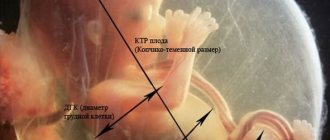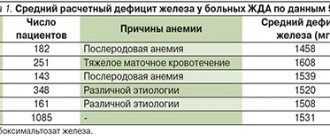Primary infection with herpes during pregnancy
The most dangerous thing for the fetus is the primary infection of a woman during pregnancy. The degree of negative impact of the virus on the embryo strongly depends on the period at which contact with the pathogen occurred.
- Infection in the first trimester will most likely lead to miscarriage. At this stage, the development of the embryo is largely subject to the “all or nothing” rule. That is, if any developmental pathologies occur in the embryo, nature will try to end the “defective” pregnancy. If the fetus is infected from the mother, but the pregnancy continues to develop, then there is a high risk of pathologies from various organs and systems in the unborn child. At this stage, in addition to treatment by a dermatologist, it is necessary to undergo routine screening, which will show how the fetus is developing.
- The second trimester is the most favorable for the condition of the woman and the embryo. Infection with the herpes virus at this stage can also provoke abnormalities in the development of the nervous system, visual and hearing organs, however, miscarriages and miscarriage at this stage are rare.
- Primary infection with herpes in the third trimester can have little effect on the formation of organs and systems, since their formation has already taken place, however, it can lead to a lag in physical development. There are frequent cases where the herpes simplex virus was the cause of intrauterine fetal death.
From this it is worth concluding that the expectant mother must maintain careful hygiene in order to avoid, if possible, infection with herpes. Some people believe that if you are a carrier of papillomavirus, you cannot also become infected with herpes. Doctors do not share this opinion, since often both pathogens are diagnosed in one person.
On the issue of diagnosing herpetic infection in pregnant women
Herpes simplex virus (HSV) is often the cause of the development of neurological, somatic and endocrine problems in newborns and older children [3]. The genital localization of herpes is especially dangerous, which occurs in 7–35% of cases in pregnant women [2, 6].
The purpose of this work was to study the optimization of the diagnosis of herpetic infection in pregnant women with a burdened obstetric and gynecological history (OAGA) in the dynamics of pregnancy.
74 multigravida women were examined: 49 primiparous and 25 multiparous. The age of the patients ranged from 20 to 41 years. All women had OAHA, and they were sent to MONIIAG with a diagnosis of “chronic herpes viral infection.” The study was carried out over time, starting from 16–24 weeks. pregnancy.
To identify HSV markers, virological (rapid culture method - RCM), molecular biological (PCR, real-time PCR) and serological (ELISA) methods were used. Blood, urine and urogenital scrapings were studied as clinical material from pregnant women. The viral load in various clinical materials was assessed by the amount of HSV DNA, which was determined by RT-PCR. For each sample, the value of the threshold cycle Ct (threshold cycle—the point at which fluorescence exceeds the background value) was recorded and the medians were calculated. The obtained threshold cycle (Ct) values were compared with the values of standard control samples with known DNA content in the sample. To assess the parameters of the humoral response, blood serum was examined by ELISA for the presence of specific antibodies to HSV (AT) of the IgM and IgG classes. The activity of antibodies, which was expressed in titers, and the avidity of IgG-AT, which was judged by the avidity index (AI), were also determined.
Among the examined pregnant women, there was a high level of infection: 43 (58%) of 74 women were diagnosed with some kind of urogenital infection (UGI) of viral and/or bacterial etiology. The method for diagnosing UGI is PCR with a qualitative assessment of the result. A detailed study of the anamnesis revealed that mixed UGI was identified in 21 (28%) pregnant women. The infection structure included a whole range of UGI pathogens: Ureaplasma urealiticum, Micoplasma hominis, Toxoplasma gondii, Gardnerella vaginalis, Chlamidia trahomatis, Candida albicans, Human papillomavirus. In 22 (30%) pregnant women, a single UGI pathogen was detected: Ureaplasma urealiticum - in 15 (20.4%), Micoplasma hominis - in 4 (5.4%). The patient had no complaints, and no clinical signs of infection were noted. Gardnerella vaginalis was found in 3 (4.2%) pregnant women.
At the first stage of the examination of patients, a comparative analysis of the frequency of detection of direct markers of HSV (infectious activity of the virus and HSV DNA) was carried out. None of these women had any clinical manifestations of genital herpes during the examination. The patient was considered infected if a viral marker was detected in at least one clinical material studied. During the entire examination period, HSV markers were detected in 18 (24.3%) pregnant women. At the same time, HSV DNA was detected in 15 (20.3%) pregnant women, and the infectious virus was detected in 3 (4%) women (Fig. 1). The differences in the frequency of detection of HSV DNA compared with infectiously active virus were statistically significant (p<0.05).
The frequency of detection of HSV in various clinical materials was determined. 525 biological materials from pregnant women were examined for the presence of direct markers of HSV: 175 samples of blood, urine and urogenital scrapings. When analyzing all studied samples using a total of all methods used (BCM, PCR and RT-PCR), most often HSV markers were detected in urogenital scrapings (27/175, 15.4%) and urine samples (20/175, 11.4%) , significantly less often - in the blood (4/175, 2.3%, p<0.05).
Along with the summary assessment, a comparative analysis of the frequency of detection of HSV markers was carried out depending on the method. HSV DNA was detected by PCR in 16/525 (3%) samples, and by RT-PCR in 30/525 (5.7%) samples. Statistical analysis showed that the RT-PCR method detected viral DNA significantly more often than the classical PCR method (p<0.05). An infectiously active virus in biological materials (BMS) was detected much less frequently than HSV DNA - in 5/525 (1%) samples. Thus, the sensitivity of HSV detection by rt-PCR was higher than that of the other two methods used.
The low frequency of detection of HSV by the BCM method in clinical samples can be explained either by the absence of an infectiously active virus in these samples in the presence of viral DNA, or by the lower sensitivity of the BCM method compared to PCR.
Studies have shown that the amount of DNA found in urine and urogenital scrapings is higher than the amount of DNA in blood samples. When statistically processing the threshold cycle (Ct) values, the differences turned out to be statistically significant (p<0.05).
A study of blood serum showed that 64/74 (86.5%) pregnant women had anti-HSV-IgG antibodies during the initial examination. Anti-HSV-IgG antibodies were absent in 10 (13.5%) women. In 2 (2.7%) pregnant women, during the initial examination, in addition to IgG-AT, IgM class antibodies were detected, which are markers of the acute phase of infection.
When assessing the avidity of IgG-Abs, it was found that in all 64 (86.5%) women in whom IgG-Abs to HSV were detected, the antibodies were characterized by high avidity (AI>50).
Pregnant women were examined over time at three stages of pregnancy: in the second and third trimester and before childbirth. During the initial examination in the second trimester of pregnancy, HSV markers were detected in 12 (14.8%) women using BCM and/or PCR methods. In 8 (12.2%) pregnant women, the detection of HSV markers was combined with the detection of high-avidity IgG antibodies (AI>50) with high titers (1:320). Of the pregnant women examined, IgG-Abs were not detected in two, which indicates a primary infection.
Changes in the concentration of IgG-AT or detection of antibodies with high titers in blood serum during a dynamic study were accompanied by the detection of direct markers of HSV during the entire examination in 3 pregnant women. In one pregnant woman, IgG Abs were never detected, despite the detection of HSV markers throughout the study.
In 2 (3%) women, direct markers of HSV were detected during the initial examination in combination with IgM-AT. One of these women's pregnancy ended in spontaneous miscarriage in the second trimester.
In the third trimester of pregnancy, HSV markers were first detected in 3 out of 74 pregnant women. A serological study showed that one woman did not have antibodies to HSV. Upon further examination of this pregnant woman, the appearance of low-avidity (IA<50) IgG-Abs with low titers of 1:20 was observed. This indicated a primary infection. In 2 patients, the infection reactivated; in one, high-avidity IgG antibodies were detected with high titers of 1:320, in the other, the antibody titer was 1:20.
The last examination of women before childbirth showed that HSV markers were detected for the first time in 3 pregnant women, despite the presence of antibodies to HSV, which indicated reactivation of herpes infection.
In 4 (5.4%) pregnant women, HSV markers were detected throughout the examination. When analyzing the viral load in clinical samples, it was found that in 2 pregnant women the viral load increased dynamically with increasing gestational age: from 100 copDNA/ml at the initial examination to 10,000 copDNA/ml at the last examination. In the other two, no changes in viral load were recorded.
Thus, according to the results obtained, starting from the second trimester of gestation, reactivation of the herpes viral infection occurred in 15 (20.3%) of 74 pregnant women. Primary infection was diagnosed in 3 (4.0%) pregnant women, with 2 (2.7%) patients infected in the second trimester of pregnancy and 1 (1.3%) in the third. Asymptomatic carriage was detected in 49 (66.2%) pregnant women. In 7 (9.5%) women referred to MONIIAG with a diagnosis of chronic HSV infection, HSV infection was absent throughout pregnancy (Fig. 2).
A serological examination of 74 pregnant women over time showed that reactivation of herpes infection is not always accompanied by the detection of high titers of IgG-AT or an increase in titers over time. Thus, in 3 out of 15 (40%) women with HSV reactivation, IgG-Ab titers with low values (from 1:20 to 1:80) were detected.
Conclusions. The frequency of detection of markers of herpetic infection in pregnant women depends on the diagnostic methods used (virological, molecular biological, serological) and the diagnostic media studied (blood, urine, urogenital scrapings). Molecular biological methods (PCR, RT-PCR) have the greatest diagnostic value when examining material from environments such as urine and urogenital scrapings.
Reactivation of herpes infection is not always accompanied by the detection of high titers of IgG-AT or an increase in titers over time. This indicates the low ability of the pregnant woman’s immune system to produce a sufficient amount of antibodies even in the presence of direct markers of HSV and proves the need for immunocorrective measures in pregnant women at high infectious risk.
Literature
- Makatsaria A.D., Bitsadze V.O., Akinshina S.V. Systemic inflammatory response syndrome in obstetrics. M.: Med. information agency. 2006. P. 448.
- Nikonov A.P., Astsaturova O.R. Genital herpes and pregnancy // Gynecology. 2002. T. 4. No. 1. P. 4–6.
- Poletaev A.V., Budykina T.S., Morozov S.G. and others. Maternal infection as a cause of pathology of the fetus and newborn // Allergology and Immunology. 2001. T. 2. No. 2. P. 110–116.
- Tsinzerling A.V., Melnikova V.F. Perinatal infection: a practical guide // Practical. hand St. Petersburg: Epby St. Petersburg, 2002. P. 352.
- Anzivino E., Fioriti D., Mischitelli M. et al. Herpes simplex virus infection in pregnancy and in neonate: status of art of epidemiology, diagnosis, therapy and prevention // Virol. J. 2009. Vol. 6. No. 40. P. 1–11.
- Bursrein DN Sequally transmitted treatment guidelines // Current Opin. Pediatrics. 2003. Vol. 15. P. 391–397.
- Suligoi B., Cusan M., Santopadre P. et al. HSV-2 specific seroprevalence among various populations in Rome, Italy. The Italian Herpes Management Forum // Sex Transm. Infect. 2000. Vol. 76. P. 213–214.
Recurrence of herpes during pregnancy
If a woman was already a carrier of herpes at the time of conception, then in most cases intrauterine infection of the fetus will not occur. The embryo is under reliable protection of antibodies produced by the mother's body. However, there remains a risk of infection during childbirth. Therefore, the slightest rash of blisters on the perianal area requires immediate treatment. Doctors also recommend immediate removal of papillomas in intimate places if they appear during pregnancy.
In some cases, severe recurrent herpetic infection is an indication for cesarean section.
Complexes with this research
IVF planning Examination for preliminary preparation of a woman for the IVF procedure 9,080 ₽ Composition
Entry into IVF Examination when a woman enters the IVF procedure 15,030 ₽ Composition
Pregnancy planning. Diagnosis of infections 14 tests for expectant mothers 6,010 ₽ Composition
IN OTHER COMPLEXES
- Male infertility. Extended examination RUB 19,800
- Examination during pregnancy. 1st trimester 10,390 RUR
- Miscarriage RUB 29,050
Causes
The herpes virus is transmitted from an infected person. Infection can occur either from a patient with severe symptoms or in a latent (asymptomatic) stage. The virus can be contained in all biological secretions of the patient (saliva, semen, contents of rashes, etc.).
Infection can occur in the following ways:
- airborne (through a kiss);
- contact and household (dishes, medical instruments, toys, etc.);
- sexual;
- transplacental (from mother to fetus during pregnancy);
- vertical (during childbirth);
- parenteral (through blood, for example, during transplantation of infected organs, blood transfusion, IVF).
Genital herpes can be primary and secondary (repeated manifestations, relapse).
The course of the disease can be normal (rashes in certain places) or severe (spread throughout the body).
Symptoms of herpes virus infection
HSV-1 and HSV-2 have similar symptoms:
- burning and itching in the affected areas;
- the appearance of vesicles (bubbles) with liquid transparent contents after burning and itching. After a few days, these rashes open and their contents flow out, forming ulcers;
- increased body temperature (up to 38-39 degrees);
- general weakness, malaise.
A significant feature of herpes is the transition to a latent state (into “hibernation”) with further activation when the immune system is weakened. Once it enters the body, the virus lives in it throughout its entire life. During the latent period, the virus is not dangerous.
During primary infection, the period of severe symptoms is 15-16 days on average. And the duration of relapses is 8-10 days.
There is also an asymptomatic course of the disease (less commonly). This is when there are no signs of the disease, but the virus is released into the environment. That is, it is possible to infect another person.
Genital herpes (HSV-2)
With genital infection, vesicles can appear on the labia, vagina, anus and cervix.
Secondary herpes differs from primary herpes in that the symptoms are less pronounced. Relapse during pregnancy occurs due to a decrease in the woman’s immunity.
Herpes zoster
This is a severe and dangerous form of the disease during pregnancy. Characterized by unilateral skin rashes (located on one side of the body). With herpes zoster, the virus is localized in the patient’s nerve cells, which causes pain in the affected areas.
The encircling form can be of different types:
- motor (muscles are affected);
- ophthalmological (eye damage);
- Ramsay-Hunt syndrome (damage to the facial nerve, causing facial paralysis);
- hemorrhagic (vesicles contain hemorrhagic contents instead of serous transparent);
- abortive (instead of blisters, erythema and edema are formed);
- blistering (larger rashes form);
- gangrenous (deeper ulcers develop and leave a scar).
Depending on the type of herpes zoster, manifestations may vary. But they are always similar in that the rashes appear on one side (along the nerve trunks). There is also general malaise, fever, weakness, pain in the areas of the rash.
Vesicles do not appear immediately; their appearance is preceded by pinkish spots. After opening the bubbles, ulcers with crusts form in their place, which will later disappear.









